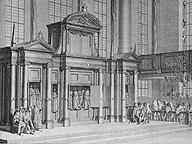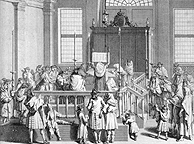Talmud
 Next to the Bible, the Talmud (which means
"study") is the most authoritative source of Jewish
law, culture, and history. Technically, the Talmud is made up
of two parts: the Mishnah and the Gemara. The Mishnah is a compilation
of Jewish laws. The Gemara is divided into two parts: the Halkakhah
and the Aggadah. The Halkakhah consists of commentary on the Mishnah
while the Aggadah is made up of texts on a variety of subjects
including history, folklore, and science. Despite this technical
division between the two parts of the Talmud, the terms Gemara
and Talmud are typically used interchangeably. Consequently, when
Jews refer to the Talmud they are usually only referring to the
Gemara portion.
Next to the Bible, the Talmud (which means
"study") is the most authoritative source of Jewish
law, culture, and history. Technically, the Talmud is made up
of two parts: the Mishnah and the Gemara. The Mishnah is a compilation
of Jewish laws. The Gemara is divided into two parts: the Halkakhah
and the Aggadah. The Halkakhah consists of commentary on the Mishnah
while the Aggadah is made up of texts on a variety of subjects
including history, folklore, and science. Despite this technical
division between the two parts of the Talmud, the terms Gemara
and Talmud are typically used interchangeably. Consequently, when
Jews refer to the Talmud they are usually only referring to the
Gemara portion.
There are two separate compilations of the Gemara or Talmud: the
Jerusalem (or Palestinian) Talmud (completed in c.425 CE) and
the Babylonian Talmud (completed in c.500 CE). The Babylonian
Talmud, which is three times the length of the Jerusalem Talmud,
is generally considered to be the more authoritative one. While
both Talmudim are written primarily in Aramaic, direct quotations
from the Mishnah are written in Hebrew.
 Since their compilation, the study of the respective Talmuds has
played an important role in the lives of observant Jews. During
the Middle Ages, Jewish schools dedicated to the study of the
Talmud, known as Yeshivot, opened throughout the diaspora. Today,
religious Jews around the world continue to read and interpret
the Talmud at Yeshivot around the world.
Since their compilation, the study of the respective Talmuds has
played an important role in the lives of observant Jews. During
the Middle Ages, Jewish schools dedicated to the study of the
Talmud, known as Yeshivot, opened throughout the diaspora. Today,
religious Jews around the world continue to read and interpret
the Talmud at Yeshivot around the world.
 Next to the Bible, the Talmud (which means
"study") is the most authoritative source of Jewish
law, culture, and history. Technically, the Talmud is made up
of two parts: the Mishnah and the Gemara. The Mishnah is a compilation
of Jewish laws. The Gemara is divided into two parts: the Halkakhah
and the Aggadah. The Halkakhah consists of commentary on the Mishnah
while the Aggadah is made up of texts on a variety of subjects
including history, folklore, and science. Despite this technical
division between the two parts of the Talmud, the terms Gemara
and Talmud are typically used interchangeably. Consequently, when
Jews refer to the Talmud they are usually only referring to the
Gemara portion.
Next to the Bible, the Talmud (which means
"study") is the most authoritative source of Jewish
law, culture, and history. Technically, the Talmud is made up
of two parts: the Mishnah and the Gemara. The Mishnah is a compilation
of Jewish laws. The Gemara is divided into two parts: the Halkakhah
and the Aggadah. The Halkakhah consists of commentary on the Mishnah
while the Aggadah is made up of texts on a variety of subjects
including history, folklore, and science. Despite this technical
division between the two parts of the Talmud, the terms Gemara
and Talmud are typically used interchangeably. Consequently, when
Jews refer to the Talmud they are usually only referring to the
Gemara portion.
